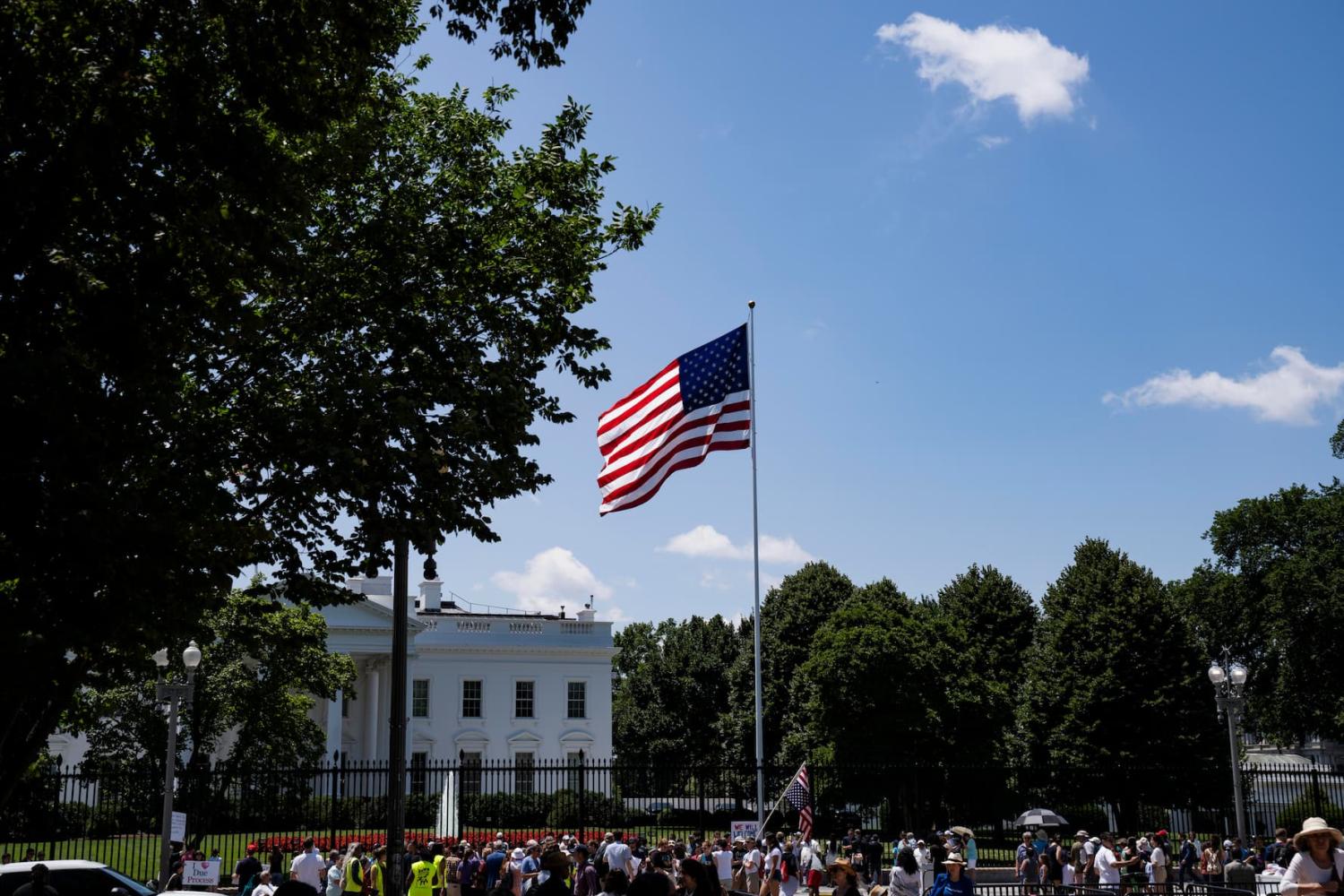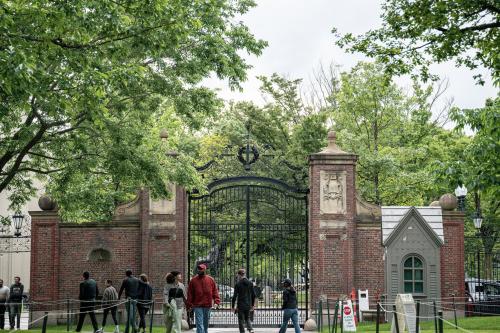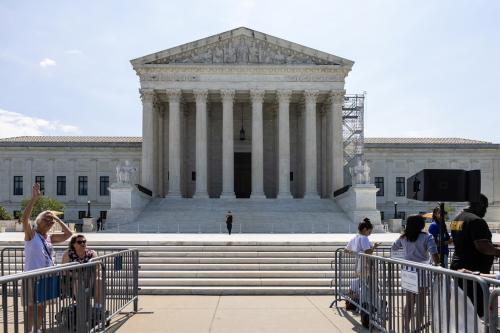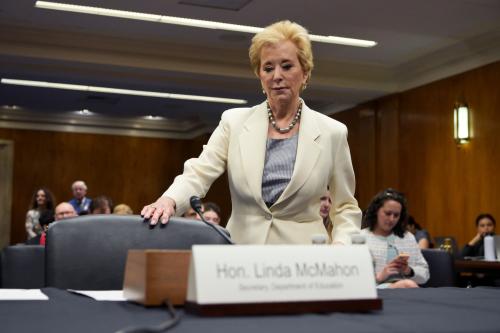Ongoing clashes between the Trump administration and elite universities threaten to discourage or even outright bar international students from coming to the U.S. to further their schooling. As I discussed in my recent Chalkboard post, cutting international college students out of the American economy would strike a heavy economic blow (estimated to cost around $44 billion), add much to the trade deficit, harm many college budgets, and badly damage businesses in many college towns.
Today’s follow-up question is where would the damage strike most heavily? Are just a few parts of the country at great risk, or would the damage be spread relatively evenly? Would just a few colleges see massive enrollment hits, or would enrollment hits be spread widely?
Based on my analysis of national data on the topic, I conclude that a handful of blue states would see large drops in spending by international students, but past that, the drop is spread roughly evenly across the country. Relatively few colleges would lose a large share of their undergraduate enrollment, but those at the highest risk are heavily concentrated among private rather than public colleges. Most of the more vulnerable colleges are not very large and have a special focus, such as art, music, or business. Also, colleges affiliated with Christian churches would be disproportionally affected. One suspects this was not the Trump administration’s intention.
Before looking at the (somewhat messy) answer, I offer an important caveat. We don’t yet know whether the number of international college students will decline significantly—or, if it does, how soon that might happen. At the moment, getting a student visa has become difficult. In fact, consular interviews to apply for new or renewed student visas were completely frozen and have just recently been reopened with some brand new conditions added. Early data suggests a large drop in the number of student visas processed this May. Will the student visa restrictions be lifted in time for incoming freshmen to arrive this fall? We don’t know. And the majority of next year’s students are already here as returning students—they don’t need a new visa to continue their studies. Even if the visa door remains shut, it will probably take several years for the full impact to be felt.
You may have seen reports highlighting the states and schools with the largest international student populations: Inside Higher Ed offers a good overview, as does this NPR article, or you can explore the data directly from the Institute of International Education. Such reports answer some questions, though they don’t really speak to vulnerability. For example, we learn California has the most international college students. While factually true, California also has the most college students (regardless of nationality) and the most people. Whether looking at states or at individual schools, it’s far better to compare international students to the overall size of the state or school.
A straightforward way to understand the impact is through the estimated economic contribution of international college students, which averages about $130 per U.S. resident. For a typical family of four, that’s just over $500 a year in potentially lost spending. (By way of comparison, this is a little more than the value of U.S. coal production and about a fifth of the value of U.S. oil and gas production.) But naturally, that average assumes the contribution is spread evenly across the population, when in reality, international students are concentrated in college towns and campus communities. However, does the economic impact bite evenly across the country once we factor in the location of international students? Mostly, but a few places would be hit noticeably higher—and, yes, those most vulnerable to international student declines are blue states. The following picture weights the contribution of international students in each state divided by the state’s population based on NAFSA data. The states are categorized and color-coded based on the value of their economic contribution relative to the national average of $130 per person: less than $65 (below 50% of the average); $65 to $130 (50% to 100%); $130 to $195 (100% to 150%); and more than $195 (above 150%).
The first thing that strikes one from the map is that most of the country falls into the two lowest categories. And that’s right; about three-quarters of the states would see impacts at or below the national average. For example, the estimated impact in Arizona is $121 per inhabitant while in Hawaii the impact is $87 per person.
Massachusetts is a standout, high-impact state on the map with an estimated $554 per-person impact. What’s harder to see visually is that area-wise, tiny Washington, D.C., will see far and away the largest impact; there, the NAFSA estimate comes to $855 per person. New York ($319), Rhode Island ($254), and Connecticut ($218) are the only other states where the estimated impact is over $195 per state resident. While California hosts the largest number of international students, its estimated economic impact is $164 per resident—somewhat above the unweighted national average of $130, but not dramatically so. It’s comparable to the impact in more politically moderate states like Michigan ($151) and Pennsylvania ($170).
Let’s turn now to identifying which colleges are at risk of large enrollment drops and the associated financial losses. Unfortunately, the definition of “international college student” is a little more complicated than it seems. Overall, a bit over 80% of “college students” are undergraduates, and the rest are engaged in graduate studies. The distribution is very different for international students, where only about 38% are undergraduates. Another complication is that international undergraduates, master’s students, and law and medical students are usually revenue sources for universities by paying tuition. Research doctoral (Ph.D.) students often are not, as they typically assist with teaching and research in exchange for tuition and living support from the university. To further complicate matters, some master’s students are actually just “entry level” Ph.D. students—and therefore may not be paying tuition—while other master’s students are seeking professional, terminal degrees and usually are paying tuition. Federal IPEDS data does not do a great job at identifying which students are contributing tuition payments.
Absent better data, I will cut the Gordian knot by reporting institutional vulnerability based only on undergraduate enrollment (with the caveat that this leaves out some institutions that rely very heavily on international master’s students—and with the further caveat that federal data does not perfectly match data as publicly reported by colleges themselves). This decision may not make much difference in practice: You can see the comparison between undergraduate international enrollment and overall international enrollment in the table below. Whether based on international undergraduate enrollment or overall international enrollment, the distribution of institutions is similar, where only a small minority of institutions have more than 10% international students.
The next issue is how much of an enrollment hit would universities have to take to be considered a “big” hit? There is no single answer, of course. Somewhat arbitrarily, I will split schools into categories according to whether international students make up 30% or more of undergraduate enrollment, 30% to 20%, 20% to 10%, or under 10%.
The set of schools in the highest—greater than 30%—category is nearly identical whether measured by undergraduate or overall enrollment. In the mid-range vulnerability categories, there are some differences in where schools fall.
Very high international undergraduate enrollment schools differ from other schools in several ways. The first is that high international enrollment schools are overwhelmingly private. In fact, every school in the over 30% and 30% to 20% categories is private. And 87% of schools in the 20% to 10% category are private. In contrast, somewhat less than half of all institutions in the under 10% category are private. However, some public universities still face serious financial threats even if international students comprise a small share of their enrollment because tuition rates for international undergraduates are so much higher than for in-state students. As an example, at my college (University of California, Santa Barbara) international students make up about 9% of the undergraduate student body. But because tuition for international undergrads is more than triple the tuition for in-state students, the loss of tuition income from a major downturn in the number of international students would matter a whole lot.
The second characteristic of high international enrollment schools is that they are small. This is especially true of the schools in the highest international enrollment category, where the median enrollment is 271 students.
Small schools typically have less financial flexibility than larger schools. Thus, many of the schools with over 30% international undergraduate enrollment may be at special risk. Note, though, that a handful of schools in this category are larger and are either particularly prestigious (the Rhode Island School of Design and the New School in New York, for example) or have may have background support from affiliated organizations (two of the schools are supported by the Church of Jesus Christ of the Latter-Day Saints and another school has major Buddhist support) that may protect against enrollment declines.
The schools with high international undergraduate enrollment are also disproportionately schools that self-describe as having a special focus, mostly in the arts broadly defined or in business. Whether having a special focus makes a school more or less vulnerable to a loss of international students is not clear. Moody’s suggests that schools with a special focus that are not highly selective are at greater financial risk.
Possibly the most surprising characteristic of high international enrollment schools is that they are disproportionately Christian schools.
Perhaps the importance of international students to Christian schools should not be so surprising. Many Christian schools are affiliated with evangelical beliefs, spreading their faith globally. Moreover, as seen above, high international enrollment schools are disproportionately private, and a large number of private schools are Christian. (Public schools do not have religious affiliations in the United States, of course.) So, the key point is that the most vulnerable schools are disproportionately Christian—not that Christian schools as a whole are especially at risk of losing international students.
A sudden loss of 30% of enrollment may well be a disaster for an institution. While only a few schools appear to be at this level of risk, I can tell you from discussions at my school that the possibility of much smaller losses is still quite scary. One study reported on by Inside Higher Education suggests that even a partial decline in international students could have serious consequences. As IHE notes, “If the U.S. lost 15 percent of its international student population, a substantial number of colleges could experience at least moderate financial repercussions, according to one projection.”
In the end, nearly every college enrolling international students has some vulnerability to volatility and uncertainty about the future of international student demand and ease of enrolling in the United States. If you want to take a look at data for a school that’s particularly important to you, much of it can be found very easily at the National Center for Education Statistics.
The Brookings Institution is committed to quality, independence, and impact.
We are supported by a diverse array of funders. In line with our values and policies, each Brookings publication represents the sole views of its author(s).








